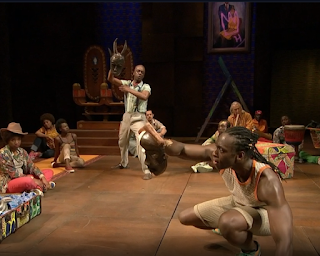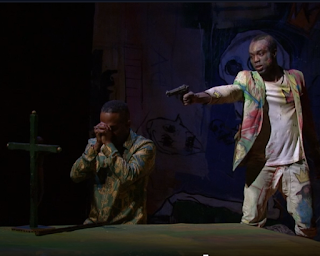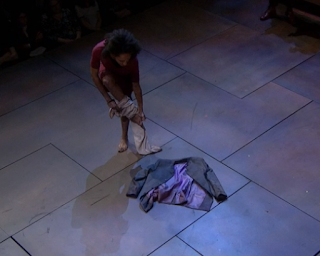Godwin's 2016 RSC Production: Act Two
Act two is slightly shorter than the opening act, at 31 minutes.
Might we add 'stingy' to our ideas of Polonius as he has to be persuaded to give more to his emissary?
Ophelia's evident distress as she explains Hamlet's behaviour towards her greatly contrasts with her composure of the previous scene. She seems to emphasise the physical: that he 'held me hard' (II.1.87), and makes reference to the transformation that we are about to witness for ourselves, 'He falls to such perusal of my face/As a would draw it' (II.i.90-91).
Now Polonius switches his own shoes, and bends down for Ophelia - reversing the dynamic of the previous scene. He seems a loving, if misguided, father attempting to do the best for his daughter. The embrace at the end of this exchange emphasises their closeness.
The representation of Rosencrantz and Guildenstern as bumbling, white, camera and luggage-laden tourists makes them as conspicuously out of joint with their environment. Their British gifts of novelty shortbread are quickly dismissed - as the more important business of their mission to intercede with Hamlet is explained.
Gertrude and Claudius evidently want to spend some time together, but Polonius has urgent business regarding his daughter. His verbosity is emphasised, but also the extent of his annoying presence for the newly-weds. Upon the wall is an ostentatious portrait of the new King and Queen.
Hamlet's 'antic disposition' manifests as a kind of manic artistic fervour for Essiedu. His crazily-daubed, paint spattered clothes testify to a night spent in some kind of artistic endeavour and his first action is to deface the portrait with a graffitied pink crown and signature 'H'. The insubordinate, challenging behaviour continues in his dialogue with Polonius.
The 'acting' of madness is clear since Hamlet is sharp enough to discern that Rosencrantz and Guildenstern have been 'sent for'. His demeanour is astute and perceptive.
The stage is filled with colour as the players arrive - and Hamlet is at its heart, with another frenzied, rhythmic and 'possessed' dance in response to the drumming. The horned mask is an effective way of representing the 'hellish Pyrrhus', and Hamlet begins rocking as his emotion is aroused by the 'silence in the heavens' at the unfolding drama. His dismissal of Rosencrantz and Guildenstern confirms that he has seen through their ploy (in spite of displays of cameraderie) and they are not to be trusted.
The closing soliloquy is emotive as Essiedu's Hamlet almost seems to physically break during the 'Bloody, bawdy villain!/Remorseless, treacherous, lecherous, kindless villain! (II.ii.576-577) climax; the plosive start descending to near collapse in the sibilant repetition of the second line.
Finally, the simple action of tearing the sticker on Claudius' throne confirms where his anger lies at this moment.





Comments
Post a Comment